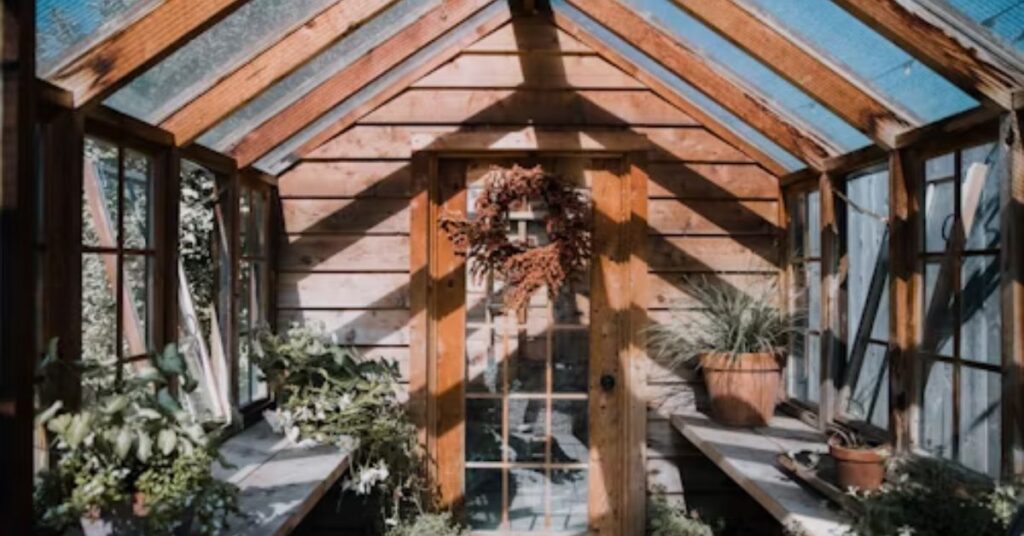In greenhouse design, one particular style remains a gold standard for efficiency, aesthetics, and durability: the gabled roof greenhouse. If you’re searching to understand what a gabled roof greenhouse is, how it functions, and why it is favored among hobbyists and commercial growers alike, this guide answers your questions directly. A gabled roof greenhouse features two sloped roof sections that meet at a central ridge, forming a classic triangle shape. This structural design isn’t just about looks—it enhances light penetration, maximizes interior space, and withstands weather better than many alternative structures.
This article provides a comprehensive deep-dive into gabled roof greenhouses, from their historical significance to the most cutting-edge innovations being implemented today. Whether you’re planning to build one or simply curious about its benefits, this is your go-to source.
Understanding the Gabled Roof Greenhouse
The gabled roof greenhouse is defined by its pitched roof structure, which forms an inverted V shape. This traditional roof geometry dates back centuries in architecture but has found specific relevance in greenhouse engineering due to its numerous environmental and structural advantages.
The steep pitch allows rain and snow to run off easily, reducing the risk of load stress on the roof. More importantly, the gable design facilitates better solar exposure throughout the day, especially in temperate and high-latitude regions where sunlight angle matters.
Key Features of a Gabled Roof Greenhouse
Below is an overview of core structural and functional elements:
| Feature | Description |
|---|---|
| Roof Shape | Two angled panels meeting at a ridge |
| Ventilation | Typically includes roof vents and side vents |
| Material | Aluminum, galvanized steel frame; polycarbonate or glass panels |
| Orientation | Usually positioned east–west for maximum light exposure |
| Insulation | Better insulation potential due to pitched shape and double-walled materials |
| Space Usage | High central ceiling ideal for vertical growth and hanging systems |
Historical Context and Modern Evolution
The gabled roof design originates from ancient Greek and Roman architecture. In the context of greenhouses, it gained traction in the Victorian era when botanical collectors required structures that offered optimal growing environments and stately aesthetics.
By the 20th century, the gabled roof became a standard form in both residential and commercial greenhouse design. Today, with the aid of modern materials like UV-resistant polycarbonate and energy-efficient glass, the gabled design continues to evolve.
Structural Integrity: Why the Gabled Roof Excels
One of the primary reasons growers opt for a gabled roof structure is its durability. The pitched design evenly distributes snow and wind loads, preventing pressure points that can lead to structural failure. In regions prone to heavy snowfall or strong winds, this factor is critical.
Additionally, the tall ridge allows warm air to rise naturally, which can then be vented out through ridge vents. This passive ventilation reduces the need for mechanical systems, lowering operational costs.
Advantages Over Other Greenhouse Roof Types
Let’s compare the gabled roof with other common greenhouse roof types to better understand its strengths.
| Roof Type | Light Penetration | Cost | Structural Strength | Ventilation | Aesthetic |
|---|---|---|---|---|---|
| Gabled | Excellent | Moderate | High | Excellent | Classic |
| Quonset (Rounded) | Good | Low | Moderate | Fair | Industrial |
| Gothic Arch | Very Good | Moderate | High | Good | Elegant |
| Flat Roof | Poor | Low | Low | Poor | Minimalist |
As shown, the gabled roof strikes a superior balance between aesthetics, function, and performance.
Design Considerations for Home Gardeners and Commercial Grower
Before building or purchasing a gabled roof greenhouse, several considerations come into play:
1. Climate Suitability
The gabled structure is especially suitable for cold and temperate climates due to its snow-shedding ability and heat retention.
2. Size and Scale
Homeowners might prefer a small 8’x10’ gabled greenhouse, while commercial growers can scale up to industrial sizes with modular frames.
3. Material Choices
- Framing: Aluminum is corrosion-resistant, while steel offers greater strength.
- Glazing: Glass for clarity and prestige, or polycarbonate for insulation and safety.
4. Ventilation Planning
Install adjustable ridge and side vents. Automatic vent openers can be added for temperature-sensitive control.
5. Foundation and Flooring
A concrete slab offers permanence, while gravel beds allow for better drainage.
Interior Layout and Plant Management
A gabled roof greenhouse provides flexible spatial design. The high central ridge makes it possible to use vertical growing systems, such as trellises or tiered shelving.
| Area | Ideal Use |
|---|---|
| Central Aisle | Walkway and main access |
| Side Panels | Benches for herbs, flowers |
| Hanging Space | Tomatoes, cucumbers, orchids |
| Floor Area | Raised beds for root vegetables |
| Upper Space | Shade cloths or lighting systems |
Such versatility allows for diverse plant cultivation within the same footprint.
Lighting, Heating, and Irrigation Systems
The inherent design of the gabled roof supports various environmental control systems.
Lighting:
Install LED grow lights along the ridge for maximum light distribution during shorter winter days.
Heating:
Use solar heaters, radiant floor heating, or gas units. The tall gable helps retain warm air during cold spells.
Irrigation:
Drip systems are preferred for water efficiency. Rainwater harvesting from the pitched roof can feed the irrigation tank.
DIY Versus Prefabricated Models
Today’s market offers both ready-to-install gabled roof greenhouses and build-it-yourself kits. Here’s a breakdown:
| Factor | DIY Build | Prefabricated |
|---|---|---|
| Cost | Lower upfront, higher time cost | Higher price, faster setup |
| Customization | Highly customizable | Limited to product options |
| Tools Needed | Extensive | Minimal |
| Skill Level | Advanced | Beginner to Intermediate |
| Durability | Depends on materials | Professionally engineered |
Both options are valid depending on your goals and resources.
Seasonal Maintenance Tips
Maintaining a gabled roof greenhouse ensures longevity and plant health.
Spring:
Clean the glazing inside and out, inspect vents, test irrigation.
Summer:
Check ventilation efficiency, use shade cloths, inspect for insect entry points.
Fall:
Flush out irrigation lines, reinforce structural integrity before snow.
Winter:
Ensure heaters are functional, monitor snow loads, seal any gaps.
Routine attention prevents long-term problems and preserves structural integrity.
Innovations and Sustainable Upgrades
Modern gabled greenhouses are now incorporating green technologies such as:
- Photovoltaic Panels: Mounted on the roof for energy independence.
- Thermal Mass Storage: Barrels of water that regulate internal temperature.
- Smart Automation: Climate sensors connected to mobile apps.
- Green Walls and Hydroponics: Vertical farming to maximize space.
These additions elevate the functionality of the traditional gabled roof greenhouse, making it future-ready.
Common Challenges and How to Solve Them
Even with its many advantages, a gabled roof greenhouse isn’t without challenges:
| Challenge | Cause | Solution |
|---|---|---|
| Condensation Drip | Poor airflow | Add roof vents, circulation fans |
| Pest Intrusion | Cracks and gaps | Use weather stripping, screen vents |
| Glazing Breakage | Hail or wind | Use twin-wall polycarbonate instead of glass |
| Overheating | Insufficient shade | Install automatic vent openers and shading nets |
Being proactive with design and materials can prevent most issues.
Gabled Roof Greenhouses in Urban Settings
While traditionally associated with suburban or rural properties, gabled roof greenhouses are now increasingly seen in urban environments, especially on rooftops. Their steep roof helps with wind load in high-rise settings and provides attractive architecture that complements modern buildings.
Urban growers also appreciate the ability to control microclimates, crucial in cities affected by the urban heat island effect.
Cost Breakdown and Investment Return
Building a gabled roof greenhouse is an investment, but it can yield significant returns in terms of produce, sustainability, and personal fulfillment.
| Cost Component | Approximate Cost (Small Scale) |
|---|---|
| Frame & Glazing | $2,000–$5,000 |
| Foundation | $800–$2,000 |
| Ventilation System | $300–$700 |
| Heating System | $500–$1,200 |
| Irrigation Setup | $250–$600 |
| Lighting & Controls | $400–$1,000 |
| Total | $4,250–$10,500 |
Homeowners often see ROI within 3–5 years through food savings and increased property value.
Case Study: Suburban Homeowner Success
A homeowner in Vermont installed a 12×16 gabled greenhouse and reported:
- Year-round supply of leafy greens
- $1,800 annual grocery savings
- Enhanced home aesthetics
- Gained a therapeutic hobby
The structure paid for itself in under four years and became a focal point of the backyard.
The Psychological and Community Impact
Beyond functional benefits, owning and operating a greenhouse has been linked to:
- Reduced stress
- Improved cognitive performance
- Stronger community networks through plant sharing
In community gardens, gabled greenhouses often become communal centers for education, food justice, and neighborhood beautification.
Final Thoughts
The gabled roof greenhouse isn’t just a relic of classical architecture—it is a forward-looking, practical solution for modern growers. Combining strength, beauty, and adaptability, it addresses nearly every concern a horticulturist might have: climate, space, cost-efficiency, and aesthetics. Whether you’re a first-time gardener or a seasoned grower seeking to expand, a gabled roof greenhouse offers both reliability and opportunity. In a changing climate and food-conscious world, it is more than just a structure—it’s a strategy.
FAQs
1. How do I choose between glass and polycarbonate panels for my greenhouse?
Glass offers clarity and traditional aesthetics but is heavier and more fragile. Polycarbonate is lighter, shatter-resistant, and provides better insulation—ideal for regions with extreme temperatures.
2. Can a gabled roof greenhouse be used year-round in cold climates?
Yes, with proper insulation, heating, and double-layer glazing, a gabled greenhouse can support year-round growing even in snowy, sub-zero environments.
3. What ventilation systems work best in a gabled roof greenhouse?
Roof ridge vents combined with side vents or exhaust fans provide optimal cross-ventilation. Automatic vent openers are recommended for temperature-sensitive control.
4. How much sunlight does a gabled roof greenhouse need per day?
Most plants thrive with 6–8 hours of direct sunlight. The gabled design maximizes exposure during morning and afternoon hours, especially when oriented east–west.
5. Are gabled roof greenhouses compatible with rainwater harvesting systems?
Absolutely. The pitched roof efficiently channels rain into gutter systems, making it easy to collect and store water for irrigation purposes.







